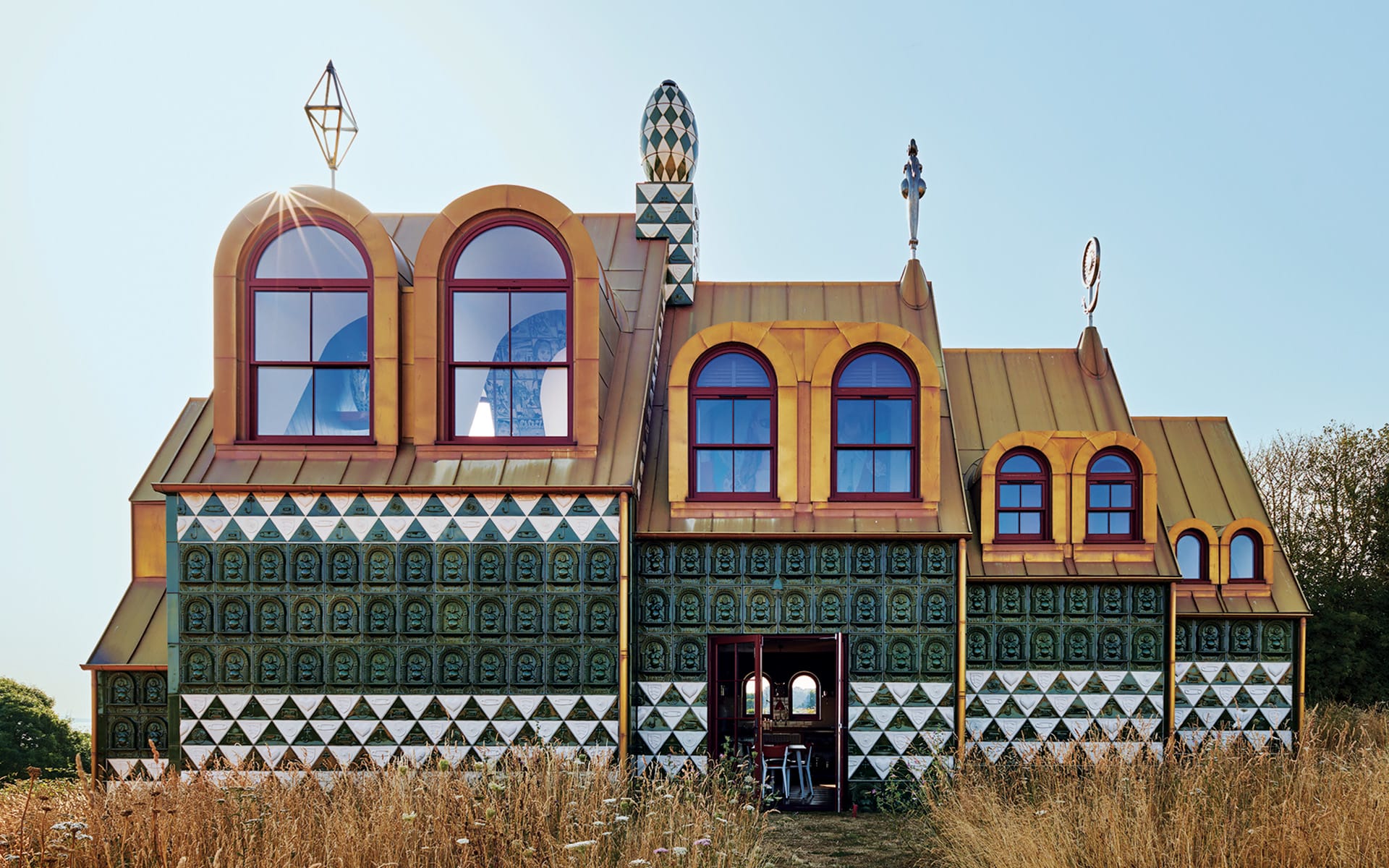Grayson Perry Creates a House That’s a Living Work of Art
An English countryside retreat created by the artist along with architect Charles Holland immerses guests in an eccentric, visually captivating story

Many buildings claim to be works of art, but the one-of-a-kind retreat known as A House for Essex makes a more convincing case than most.
Named for the English county where it is located, near the village of Wrabness, along the River Stour, the home is a collaboration between artist Grayson Perry and architect Charles Holland. Referencing memorial chapels, follies, and dachas, A House for Essex is an arresting, emphatically imaginative presence in an area celebrated for its nature preserves and birds.

“I was born in Chelmsford and I lived in Essex until I was 19, so Essex formed me in many ways,” says Perry, best known for his richly detailed ceramics and tapestries, threaded through with narrative and wry social commentary. “When we saw the site it felt like somewhere a chapel would be built, on the edge of a tiny village. It also had a nice aspect over the river, with the Essex Way path running past. Immediately, we knew that’s where it was going to be.”

The house is part of Living Architecture, a portfolio of bespoke holiday retreats that are available for rent and intended as a way of introducing guests to the delights of modern architecture, as created by Peter Zumthor, John Pawson, MVRDV, and others. Living Architecture’s founder, the philosopher and writer Alain de Botton, had raised the idea of working with Perry and eventually managed to persuade him to take on A House for Essex in conjunction with Holland, also an Essex native. It was the last project Holland completed as part of the since-disbanded architectural collective Fashion Architecture Taste, or FAT, where he was a director.


“I would describe the house as a very, very rare instance of genuine collaboration between art and architecture,” says Holland, who now heads a practice under his own name. “A shared enthusiasm for decoration, ornament, and the possibility of architecture as storytelling meant that we worked very closely and symbiotically.”
Early on in the five-year project, Perry introduced the fictional character Julie Cope and began to write a poem that would chronicle her life in Essex, including two marriages, various struggles and adventures, and her tragic death. “The Ballad of Julie Cope” evolved along with A House for Essex, which Perry and Holland designed around the idea of a memorial chapel built in her honor, a place where Julie’s life story would be told through the ceramics, tapestries, and other artworks created by Perry, as well as through the architecture.

“It’s a Taj Mahal on the River Stour, built in mourning by her husband,” the artist says. “That’s the kind of myth that permeates the house. It evolved organically, very much in dialogue between me and Charles.”
As well as telling Julie’s story, A House for Essex also has to function as a holiday home. Its overall form is a series of staggered, progressively larger and higher peaked volumes, so that the house expands gently from front to back. The exterior walls are clad in green and white cast ceramic tiles featuring motifs designed by Perry. The golden brass roof, inset with arched dormer windows, is ornamented with sculptural elements that include a weather vane–like figure of Julie looking over the environs. Undeniably surreal, the house also manages to blend into the Essex landscape with a color palette that mirrors the trees and cornfields.

Inside, Holland added Adolf Loos–inspired touches and Arts and Crafts references, such as the built-in banquettes and the fireplace surround of silvery tiles in the living room. Perry, meanwhile, worked on the sequence of Julie-centric art pieces that carry through the house, culminating in a memento mori–like floor mosaic with a skull and an epitaph for her on the enclosed back porch.

“Julie acted as a sort of surrogate client, partly because as a holiday home it didn’t have a client in the traditional sense,” says Holland. “We would often ask ourselves, What kind of kitchen would Julie have? Would she have an avocado-colored bath suite?”
Perry recalls the process in much the same way. “For me, it was always an interesting negotiation with fantasy, my taste, and Charles’s taste,” he says. “I think I erred toward ‘hobbity,’ and Charles cleaned it up and gave a more modern look to the house.” Perry has since stayed there a few times himself. “It does work very well as an artwork that you live in,” he says. “You immerse yourself in the biography. But I think the thing that pleased me most was just how alien it looks in the landscape yet at the same time, it also fits in.”

Layered with symbolism and narrative, full of delight, A House for Essex is quite unlike anything else in the Living Architecture collection. Or anywhere else, for that matter.
A House for Essex is featured in The Iconic British House: Modern Architectural Masterworks Since 1900 by Dominic Bradbury and Richard Powers, recently published by Thames & Hudson.
A version of this article first appeared in print in our 2023 Winter Issue under the headline “These Walls Can Talk.” Subscribe to the magazine.